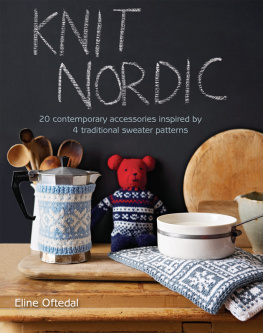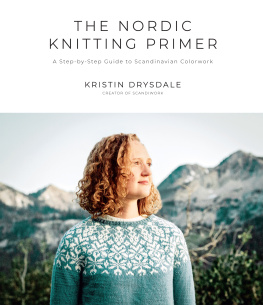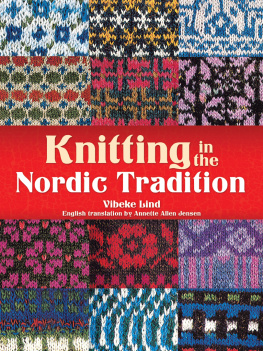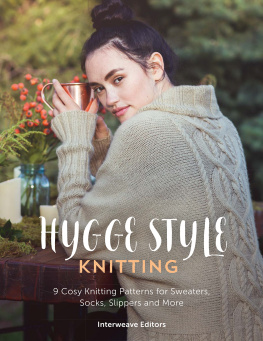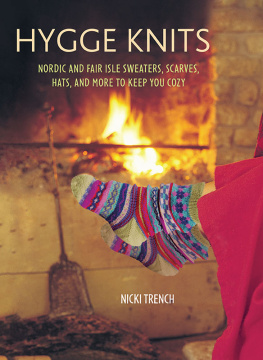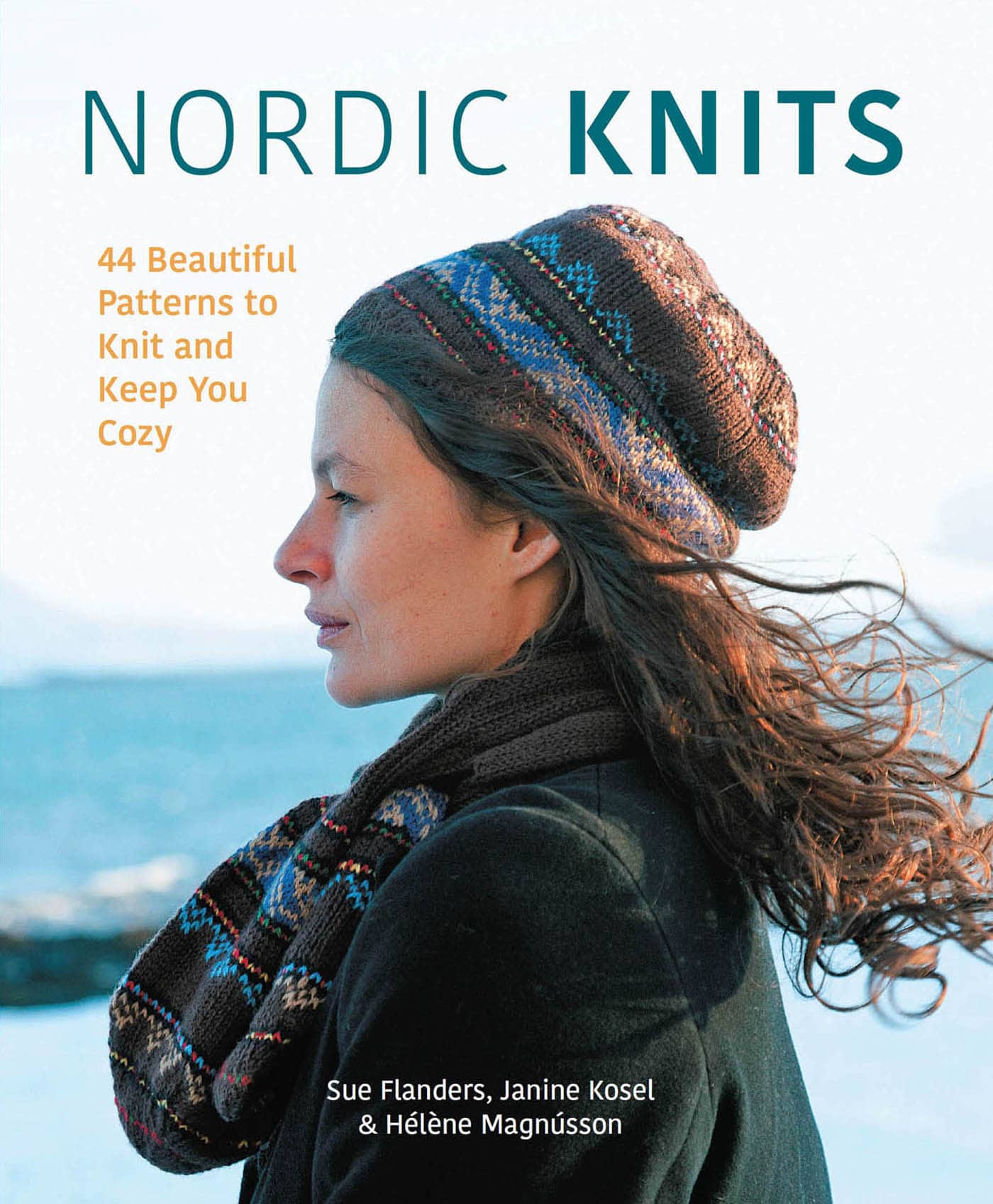Contents
Page List
Guide
Cover
NORDIC
KNITS
44 Beautiful Patterns to Knit and Keep You Cozy
Sue Flanders, Janine Kosel & Hlne Magnsson
CONTENTS
INTRODUCTION
N ordic Knits is an exploration in knitwear inspired by the traditional knitting styles of Norway, Sweden, and Iceland. These three countries, steeped in textile history, offer a wealth of inspiration to draw on. The patterns throughout were influenced by the different cultures and practices native to each country.
Think of the Norwegian sweaters that we love so much (and need in cold climates)they have very humble beginnings. Some of the earliest sweaters, worn by men, were considered underwear. The sweaters were worn over a shirt and tucked into trousers, with a vest and coat worn over the top. Many of these sweaters featured two-color designs because of the extra warmth the second yarn provided, but because the undershirt/sweaters were tucked into trousers, the sweaters featured only one color below the waist to save time and conserve yarn. Luckily for us, Norwegian sweaters became outerwear for everyone, young and old. For some, sweaterslike the Adult Voss Sweaterhave become a palette for creative expression, for others a source of pride in Norwegian heritage. You dont have to be Norwegian to love Norwegian knitting, though; you just have to appreciate beauty, warmth, and a little bit of history.
Knitting was a vital skill in Norway. Women used wool that they had processed, beginning with raising sheep, shearing them, carding the wool, and spinning it into yarn. Many Norwegian immigrants living in the American Midwest in the nineteenth century also raised sheep for their warm, soft, durable wool and for meat. Although immigrant women could have purchased ready-knit items or yarn for knitting, they often processed their own wool for yarn. Immigrants believed that hand-spun wool yarn and hand-knit objects were betterwarmer and more durablethan what they could buy in the store.
Aside from warmth and durability, knitting was also valued for its beauty. Colorfully embroidered mittens and gloves were worn to church in Norway. In Selbu, near Trondheim, it was a tradition for the bride to give patterned mittens to all the members of her wedding party. Knitting was an expression of creativity and skill. Immigrants brought many of these skills, traditions, and textiles with them when they immigrated to the United States.
When Swedish immigrants came to America, they brought tools and knowledge of practices that provided linens and domestic textiles for families of settlers throughout the Midwest. Swedish textile crafts, including bed coverlets, loom-woven rugs, tablecloths, and runners, are particularly fascinating, and there is a wealth of accessible historical examples in both Sweden and Swedish America. In some areas of Sweden, successive craft traditions have never been broken, spanning centuries of transition from agrarian society to todays twenty-first-century technology.
When 1800s industrialization consumed manpower from traditional households, Swedish textile crafts were generally those that survived. The Handcraft Movement, a reaction to extensive industrial production, redirected attention to home craft production. Textile crafts like loom-woven linen and rugs, spinning, embroidery, and knitting played an important role in the birth of the Handcraft Movement and remain among the strongest practiced handcraft traditions today in Sweden. Traditional pieces reveal how Swedish traditions were continued in this country and how those traditions influenced textiles more generally in the Midwest.


English, German, or Dutch merchants may have brought knitting to Iceland. Knitting quickly spread throughout the country and soon became the main cottage industry. Everyone was knittingyoung and old, men and womenand all were supposed to produce a specified amount of knitted goods over a certain period of time. People were knitting both refined knits on tiny needles for special occasions and more utilitarian garments for their own everyday use. They were also knitting an enormous quantity of goods, probably much rougher and in plain colors, aimed for exportation.

The Icelandic knitting of today conjures up visions of lopi yoke sweaters knit in natural colors, but you wont find any lopi sweaters in the textile museums in Iceland. The reason for that is simple: The traditional Icelandic sweater is a relatively recent invention. In the 1950s, as yoke sweaters became fashionable in the Western world, a yoke sweater with a definite Icelandic flair emerged, and by the 1970s, it was immensely popular. The unspun lopi with which the lopapeysawhich literally translates to sweater in lopi woolis knitted is a bit older, dating back to the early 1900s, when lazy women began to knit without spinning the wool into yarn first.
And now it has all been gathered in one place: Norwegian mittens, Swedish hats, Icelandic sweaters, and much more. Knit using traditional techniques as you work your way through these contemporary patterns based on historical practice. There is a rich Nordic knitting heritage, and youll find much of it here in Nordic Knits.
NORWEGIAN
HANDKNITS
N orwegian knitting usually conjures up visions of ski sweaters worn by the Scandinavian teams at the Winter Olympics. It was the beauty and relative simplicity of these sweaters that inspired this collection of patterns, much of which came from exhibitions at Norwegian museums that display spinning, nlbinding, Setesdal embroidery, band weaving, bentwood box making, and felt making. Vesterheim is the oldest and most comprehensive museum in the United States dedicated to a single immigrant group, Norwegian Americans; the sheer magnitude of their textiles collection is very impressive: drawers filled with colorful mittens and gloves, racks loaded with incredible embroidered bunads, and rolls of exquisite tapestries.
As knitters, we are the farmers, and the designs in this book are the seeds. And we can nurture these old fiber traditions to ensure they are not forgotten, and help preserve the heritage of the Norwegian people who immigrated to their western home.
The inspiration for some of the patterns came very naturally by just modifying old designs. Other patterns, such as the Voss Family Sweaters, took extensive study of the artifact and days of graphing various pattern possibilities. The end result is a collection of patterns steeped in Norwegian history that we hope you will enjoy knitting for family and friends.


